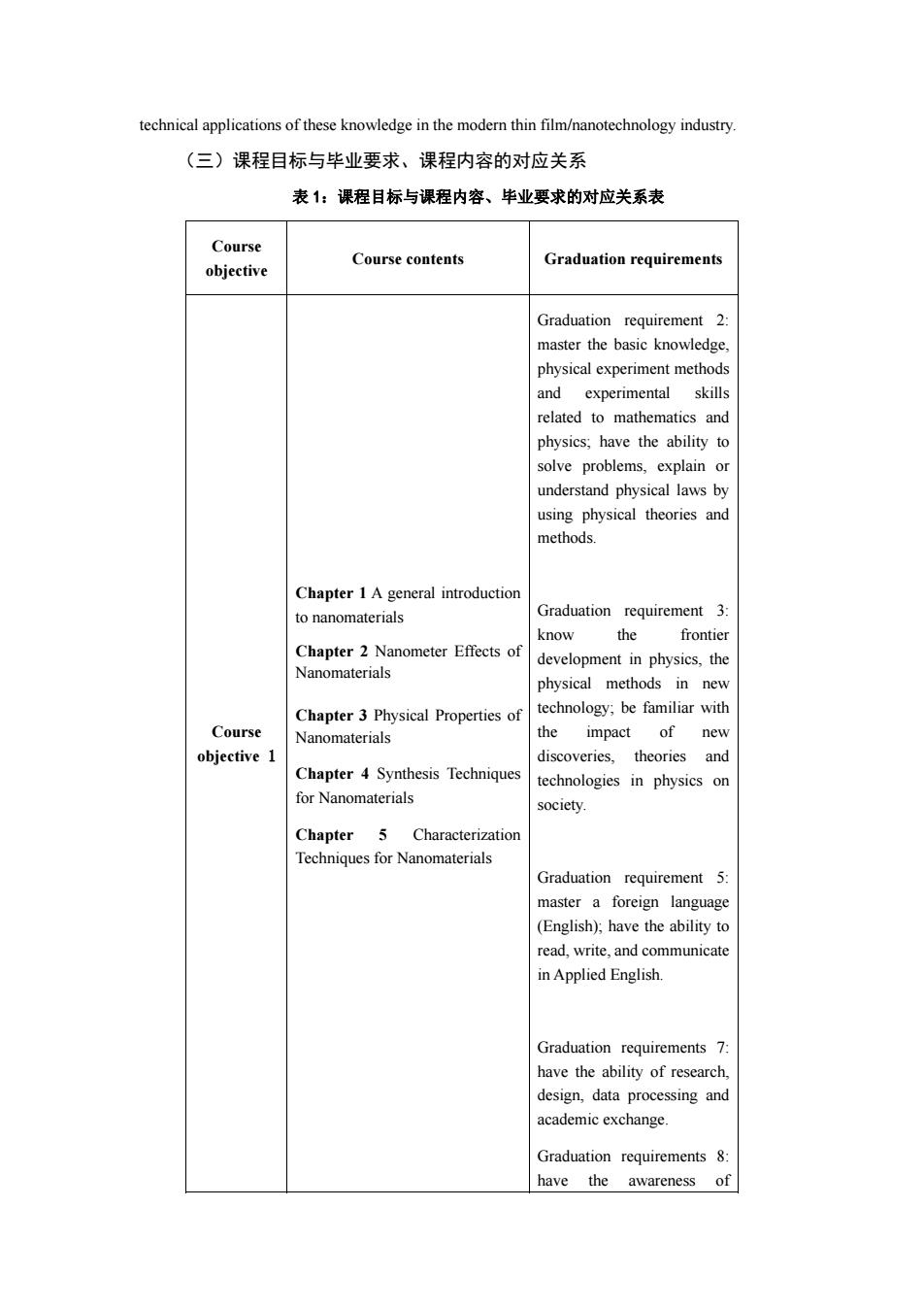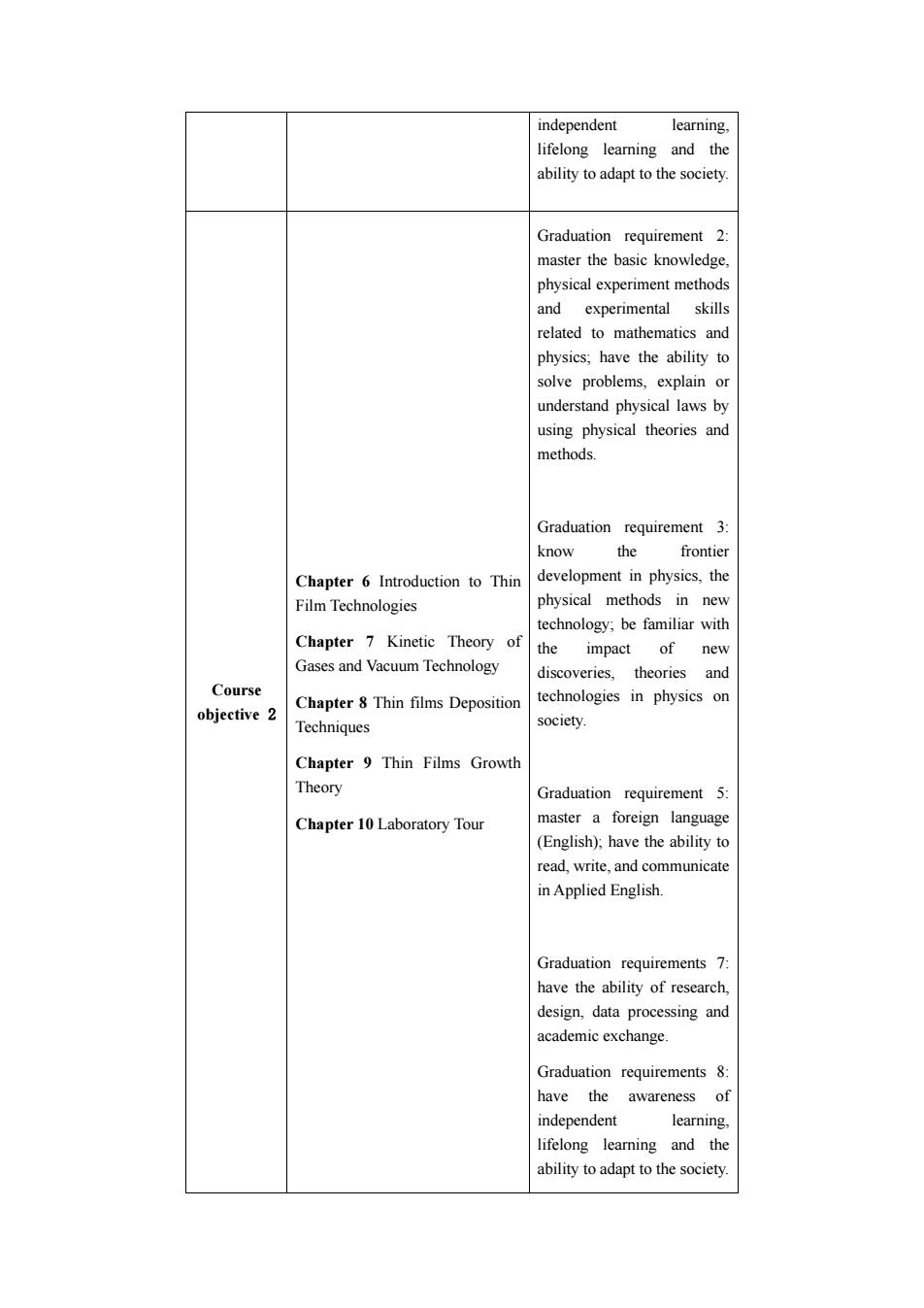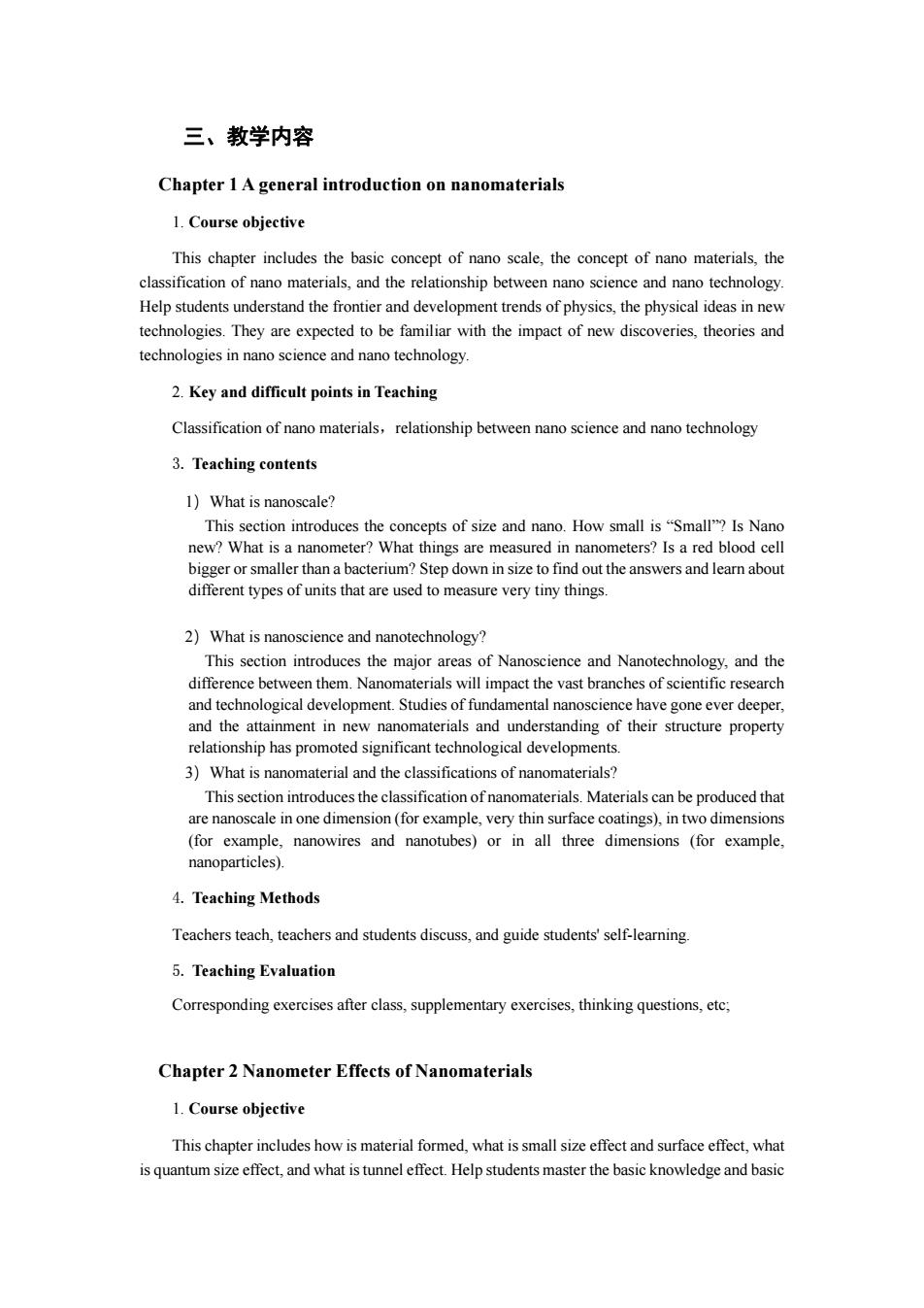
《薄膜技术与纳米材料(英文)》课程教学大纲 一、课程基本信息 英文名称 Thin Films Technology and Nanostructure Materials 课程代码 PHYS3118 课程性质Major Elective 授课对象 Physics 学分 2 学时 36 主讲教师 Rujun Tang(汤如俊) 修订日期 2021.9 1 Rujun Tang.Introduction to Thin Film Materials and Technology>,Soochow UniversityPress,ISBN:978-7-5672-3579-3(2021) 指定教材 2. Yaojun Zhang. Fundamentals of Nanomaterials Chemistry Industry Inc publisher,ISBN:9787122101297(2011). 二、课程目标 (一)总体目标: The discipline ofthin films technology and nanostructure materials is a new scientific field that chemistry, onicsandoherdisciplinesandhasafareaechingimpaetoncondensg matter physics and materials.This course is a professional improvement course related to condense matter physics and material science.The task of the course is to enable students to understand and master the basic concepts of nano materials and thin film technologies,and the research progress of ano materials and thin film technologies.With the study of this course,we will cultivate students' ininterdisciplinary cnable students to understand the lates evelopment trend of nano materials and thin film technologies.It will als expand their scientific and technological vision,improve their scientific research quality and ability, and lay a foundation for knowledge innovation and technological innovation. (二)课程目标: Course objective 1:Understand the basic definitions of the length-scale:Understand the nanometer effects and physical properties of nanomaterials,Know some preparation techniques of nanomaterials,and know some characterization techniques of nanomaterials Course objective 2:Understand the basic knowledge of vacuum,the physical and chemical film/nano physics and
《薄膜技术与纳米材料(英文)》课程教学大纲 一、课程基本信息 英文名称 Thin Films Technology and Nanostructure Materials 课程代码 PHYS3118 课程性质 Major Elective 授课对象 Physics 学 分 2 学 时 36 主讲教师 Rujun Tang(汤如俊) 修订日期 2021.9 指定教材 1. Rujun Tang, 《Introduction to Thin Film Materials and Technology》,Soochow University Press, ISBN: 978-7-5672-3579-3(2021). 2. Yaojun Zhang, 《 Fundamentals of Nanomaterials 》 ,Chemistry Industry Inc. publisher, ISBN: 9787122101297 (2011). 二、课程目标 (一)总体目标: The discipline of thin films technology and nanostructure materials is a new scientific field that has attracted much attentions in recent years. It involves the knowledge of condensed matter physics, chemistry, materials, electronics and other disciplines, and has a far-reaching impact on condensed matter physics and materials. This course is a professional improvement course related to condensed matter physics and material science. The task of the course is to enable students to understand and master the basic concepts of nano materials and thin film technologies, and the research progress of nano materials and thin film technologies. With the study of this course, we will cultivate students' comprehensive ability in interdisciplinary science, enable students to understand the latest achievements and development trend of nano materials and thin film technologies. It will also expand their scientific and technological vision, improve their scientific research quality and ability, and lay a foundation for knowledge innovation and technological innovation. (二)课程目标: Course objective 1:Understand the basic definitions of the length-scale; Understand the nanometer effects and physical properties of nanomaterials; Know some preparation techniques of nanomaterials, and know some characterization techniques of nanomaterials. Course objective 2:Understand the basic knowledge of vacuum, the physical and chemical vapor deposition techniques, and some thin film growth mechanism. After finishing this course, the students are supposed to have some basic understanding on both the thin film/nano physics and

technical applications of these knowledge in the modern thin film/nanotechnology industry. (三)课程目标与毕业要求、课程内容的对应关系 表1:课程目标与课程内容、毕业要求的对应关系表 Course Course contents graduation requirements objective Graduation requirement 2 master the basic knowledge. physical experiment methods and experimental skills mathem natics and physics,have the ability to solve problems,explain or understand physical laws by using physical theories and me Chapter1 general introductior to nanomaterials Graduation requirement 3: know the frontier Chapter 2 Nanometer Effectso als development in physics the physical methods in nev Chapter 3 Physical Properties of echnology;be familiar with Course aterials the impact of new objective 1 discoveries.theories and Chapter 4 Synthesis Techniques technologies in physics on for Nanomaterials society. Chapter 5 Characterization Techniques for Nanomaterials Graduation requirement 5: master a foreign language (English),have the ability to read,write,and mmunicat in Applied English. Graduation requirements 7: have the ability of research design,data processing and academic exchange. Graduation requirements 8: have the awareness of
technical applications of these knowledge in the modern thin film/nanotechnology industry. (三)课程目标与毕业要求、课程内容的对应关系 表 1:课程目标与课程内容、毕业要求的对应关系表 Course objective Course contents Graduation requirements Course objective 1 Chapter 1 A general introduction to nanomaterials Chapter 2 Nanometer Effects of Nanomaterials Chapter 3 Physical Properties of Nanomaterials Chapter 4 Synthesis Techniques for Nanomaterials Chapter 5 Characterization Techniques for Nanomaterials Graduation requirement 2: master the basic knowledge, physical experiment methods and experimental skills related to mathematics and physics; have the ability to solve problems, explain or understand physical laws by using physical theories and methods. Graduation requirement 3: know the frontier development in physics, the physical methods in new technology; be familiar with the impact of new discoveries, theories and technologies in physics on society. Graduation requirement 5: master a foreign language (English); have the ability to read, write, and communicate in Applied English. Graduation requirements 7: have the ability of research, design, data processing and academic exchange. Graduation requirements 8: have the awareness of

independent learning. and the ability to adapt to the society Graduation requirement 2: master the basic knowledge physical experiment method and experimental skills related to mathematics and physics:have the ability to 10 using physical theories and methods. know the frontie Chapter 6 Introduction to Thir development in physics.the physical methods in new technology,be familiar with Chapter 7 Kinetic Theory of the impact of Gases and Vacuum Technology discoveries, theories an Course technologies in physics on objective 2 Chapter 8 Thin films Depositior Techniques society. Chapter 9 Thin Films Growth Theory Graduation requirement 5: Chapter 10 Laboratory Tour master a foreign language (English),have the ability to read,write,and communicate in Applied English Graduation requirements 7: have the ability of research. design.data processing and academic exchange Graduation requirements8: have the awareness of independent learning lifelong leaming and the ability to adapt to the society
independent learning, lifelong learning and the ability to adapt to the society. Course objective 2 Chapter 6 Introduction to Thin Film Technologies Chapter 7 Kinetic Theory of Gases and Vacuum Technology Chapter 8 Thin films Deposition Techniques Chapter 9 Thin Films Growth Theory Chapter 10 Laboratory Tour Graduation requirement 2: master the basic knowledge, physical experiment methods and experimental skills related to mathematics and physics; have the ability to solve problems, explain or understand physical laws by using physical theories and methods. Graduation requirement 3: know the frontier development in physics, the physical methods in new technology; be familiar with the impact of new discoveries, theories and technologies in physics on society. Graduation requirement 5: master a foreign language (English); have the ability to read, write, and communicate in Applied English. Graduation requirements 7: have the ability of research, design, data processing and academic exchange. Graduation requirements 8: have the awareness of independent learning, lifelong learning and the ability to adapt to the society

三、教学内容 Chapter 1A general introduction on nanomaterials 1.Course objective This chapter includes the basic concept of nano scale,the concept of nano materials,the lassification of nano materials,and the relationship between nos nce and nano technology. Help studen technologies.They are expected to be familiar with the impact of new discoveries,theories and technologies in nano science and nano technology. 2 Key and difficult points in Teaching Classification of nano materials,relationship between nano science and nano technology 3.Teaching contents 1)What is nanoscale? This section introduces the co epts of size and nano How small is "Small?Is Nan new? What is a nanometer?What things are measured in nanometers?Is a red blood cell bigger or smaller than a bacterium?Step down in size to find out the answers and learn about different types of units that are used to measure very tiny things. 2)What is nanoscience and nanotechnology? the major area of Nanoscience and Nanotechnolo will impact the of se and the attainment in new rials and under anding of ther propert relationship has promoted significant technological develop nts 3)What is nan ma als? ces the classification of nanor aterials.Materials can be produced tha in one dimension (for example,very thi sur ce coatings),in tw dimensi ) (for exa nanowires and nanotubes)or in all three dimensions (for example 4.Teaching Methods Teachers teach,teachers and students discuss,and guide students'self-learning. 5.Teaching Evaluation Corresponding exercises after class,supplementary exercises,thinking questions,etc. Chapter 2 Nanometer Effects of Nanomaterials 1.Course objective This chapter includes how is material formed,what is small size effect and surface effect,what is quantum size what is tunnel Help students master the basic knowledge and basic
三、教学内容 Chapter 1 A general introduction on nanomaterials 1. Course objective This chapter includes the basic concept of nano scale, the concept of nano materials, the classification of nano materials, and the relationship between nano science and nano technology. Help students understand the frontier and development trends of physics, the physical ideas in new technologies. They are expected to be familiar with the impact of new discoveries, theories and technologies in nano science and nano technology. 2. Key and difficult points in Teaching Classification of nano materials,relationship between nano science and nano technology 3. Teaching contents 1)What is nanoscale? This section introduces the concepts of size and nano. How small is “Small”? Is Nano new? What is a nanometer? What things are measured in nanometers? Is a red blood cell bigger or smaller than a bacterium? Step down in size to find out the answers and learn about different types of units that are used to measure very tiny things. 2)What is nanoscience and nanotechnology? This section introduces the major areas of Nanoscience and Nanotechnology, and the difference between them. Nanomaterials will impact the vast branches of scientific research and technological development. Studies of fundamental nanoscience have gone ever deeper, and the attainment in new nanomaterials and understanding of their structure property relationship has promoted significant technological developments. 3)What is nanomaterial and the classifications of nanomaterials? This section introduces the classification of nanomaterials. Materials can be produced that are nanoscale in one dimension (for example, very thin surface coatings), in two dimensions (for example, nanowires and nanotubes) or in all three dimensions (for example, nanoparticles). 4. Teaching Methods Teachers teach, teachers and students discuss, and guide students' self-learning. 5. Teaching Evaluation Corresponding exercises after class, supplementary exercises, thinking questions, etc; Chapter 2 Nanometer Effects of Nanomaterials 1. Course objective This chapter includes how is material formed, what is small size effect and surface effect, what is quantum size effect, and what is tunnel effect. Help students master the basic knowledge and basic

2.Key and difficult points in Teaching How is material formed,what is small size effect and surface effect 3.Teaching contents 1)How is material formed? This section introduces the various types of chemical bonds.and discusses how the nature of the bonds gives an insight into some crystal structures.The concepts of grain and grain boundary will also be introduced. 2)What is Small Size Effect and surface effect? This section introduces the small size effect and surface effect.When the size of the particles is equal to or smaller than the physical characteristic size such as the wavelength of the light. the Deborah wavelength and the coherence length of the superconductivity,the periodic boundary conditions of the crystal will be destroyed,and the atomic density near the surface layer of the amorphous nanoparticles decreases.This leads to changes in sound,light. electricity,magnetism,heat,mechanics,and other properties that exhibit new physical properties. 3)What is Quantum Size Effect? This section introduces the Quantum Size Effect.Quantum size effects mean that when the particle size drops to a certain value.the energy levels near the Fermi level change from quasi enry gap widens.When the energy level changes more than that of thermal energy,light energy and electromagnetic energy,the magnetic. optical,acoustic,thermal,lctrical and superconducting properties of nanoparticles are significantly different from those of conventional materials 4)What is Tunnel Effect? This section introduces the phenomenon and definition of Tunnel Effect.Quantum tunneling or tunneling refers to the quantum mechanical phenomenon where a partice tunnels through a barrier that it classically could not surmount.It has important applications to modern devices such as the computingand the microscope 4.Teaching Methods Teachers teach,teachers and students discuss,and guide studentsself-earing 5.Teaching Evaluation Corresponding exercises after class,supplementary exercises,thinking questions,etc Chapter 3 Physical Properties of Nanomaterials 1.Course objective
physical experimental methods related to nano size effect, and can use physical theory to explain or understand physical phenomenon in nanoscale. 2. Key and difficult points in Teaching How is material formed,what is small size effect and surface effect 3. Teaching contents 1)How is material formed? This section introduces the various types of chemical bonds, and discusses how the nature of the bonds gives an insight into some crystal structures. The concepts of grain and grain boundary will also be introduced. 2)What is Small Size Effect and surface effect? This section introduces the small size effect and surface effect. When the size of the particles is equal to or smaller than the physical characteristic size such as the wavelength of the light, the Deborah wavelength and the coherence length of the superconductivity, the periodic boundary conditions of the crystal will be destroyed, and the atomic density near the surface layer of the amorphous nanoparticles decreases. This leads to changes in sound, light, electricity, magnetism, heat, mechanics, and other properties that exhibit new physical properties. 3)What is Quantum Size Effect? This section introduces the Quantum Size Effect. Quantum size effects mean that when the particle size drops to a certain value, the energy levels near the Fermi level change from quasi continuous to discrete energy levels or the energy gap widens. When the energy level changes more than that of thermal energy, light energy and electromagnetic energy, the magnetic, optical, acoustic, thermal, electrical and superconducting properties of nanoparticles are significantly different from those of conventional materials. 4) What is Tunnel Effect? This section introduces the phenomenon and definition of Tunnel Effect. Quantum tunneling or tunneling refers to the quantum mechanical phenomenon where a particle tunnels through a barrier that it classically could not surmount. It has important applications to modern devices such as the tunnel diode, quantum computing, and the scanning tunneling microscope. 4. Teaching Methods Teachers teach, teachers and students discuss, and guide students' self-learning. 5. Teaching Evaluation Corresponding exercises after class, supplementary exercises, thinking questions, etc; Chapter 3 Physical Properties of Nanomaterials 1. Course objective